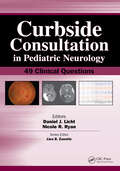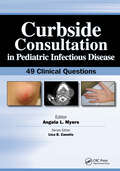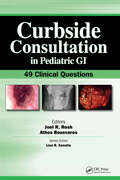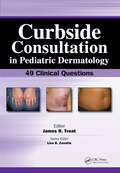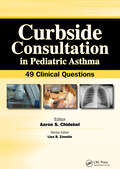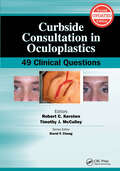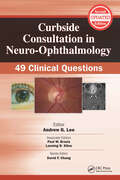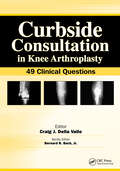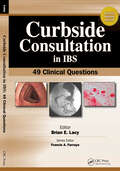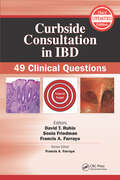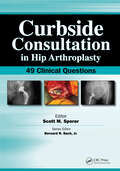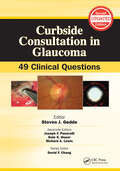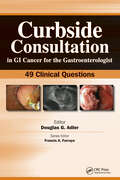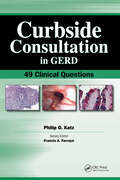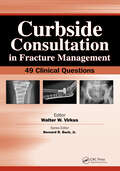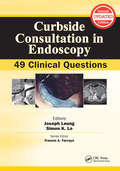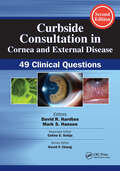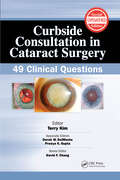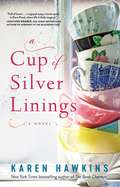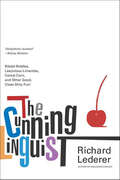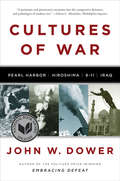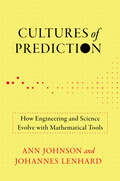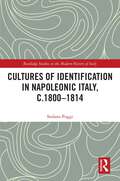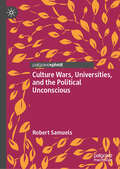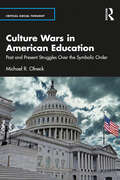- Table View
- List View
Curbside Consultation in Pediatric Neurology: 49 Clinical Questions (Curbside Consultation in Pediatrics)
by Daniel Licht Nicole RyanAre you looking for concise, practical answers to those questions that are often left unanswered by traditional pediatric neurology references? Are you seeking brief, evidence-based advice for complicated cases or controversial decisions? Curbside Consultation in Pediatric Neurology: 49 Clinical Questions provides quick answers to the tricky questions most commonly posed during a “curbside consultation” between pediatricians. Dr. Daniel Licht and Dr. Nicole R. Ryan have designed this unique reference which offers expert advice, preferences, and opinions on tough clinical questions commonly associated with pediatric neurology. The unique Q&A format provides quick access to current information related to pediatric neurology with the simplicity of a conversation between two colleagues. Numerous images, diagrams, and references allow readers to browse large amounts of information in an expedited fashion.Some of the questions that are answered: When should I consider head imaging in a child with headache? CT or MRI? What is the acute management after a concussion? When can a child return to school and sports? What are the important things to consider when you see a child with the complaint of vision changes? Are there any diet changes or vitamins that may help a child with epilepsy? What are the signs of a stroke in a child? Are there other conditions that can present like a stroke? What are common causes of acute ataxia? What are the neurodevelopmental disorders leading to language delay and what work-up is needed? What are the Causes of Guillain-Barré Syndrome, How Often Does It Occur, and How Do You Treat It? Curbside Consultation in Pediatric Neurology: 49 Clinical Questions provides information basic enough for residents while also incorporating expert advice that even high-volume pediatricians will appreciate. Pediatricians, family practitioners, and pediatric residents will benefit from the user-friendly, casual format and the expert advice contained within.
Curbside Consultation in Pediatric Infectious Disease: 49 Clinical Questions (Curbside Consultation in Pediatrics)
by Angela MyersAre you looking for concise, practical answers to those questions that are often left unanswered by traditional pediatric infectious disease references? Are you seeking brief, evidence-based advice for complicated cases or controversial decisions? Curbside Consultation in Pediatric Infectious Disease: 49 Clinical Questions provides quick answers to the tricky questions most commonly posed during a “curbside consultation” between pediatricians. Dr. Angela L. Myers has designed this unique reference which offers expert advice, preferences, and opinions on tough clinical questions commonly associated with pediatric infectious disease. The unique Q&A format provides quick access to current information related to pediatric infectious disease with the simplicity of a conversation between two colleagues. Numerous images, diagrams, and references allow readers to browse large amounts of information in an expedited fashion. Curbside Consultation in Pediatric Infectious Disease: 49 Clinical Questions provides information basic enough for residents while also incorporating expert advice that even high-volume pediatricians will appreciate. Pediatricians, nurse practitioners, physician assistants, and family practitioners will benefit from the user-friendly, casual format and the expert advice contained within. Some of the questions that are answered: • When is imaging, such as VCUG and renal US, necessary for children with a first UTI? • Are bleach baths or chlorhexidine plus mupirocin ointment useful to decolonize patients with recurrent MRSA infections? What topical recommendations are useful for patients with recurrent MRSA infections?• What is the recommended specific treatment of otitis media due to multi-drug resistant pneumococcus? • If I have a 5-week-old infant with positive rapid viral testing, who does not need hospital admission, is a sepsis evaluation necessary? • What is likely to be the most common viral pathogens causing diarrhea, since the decrease in rotavirus cases with increase in vaccine uptake?• When are tick borne infections typically seen in the US; and when does the peak time occur?Curbside Consultation in Pediatric Infectious Disease: 49 Clinical Questions will help pediatricians to manage complex diseases and guide physicians through the maze of treatments available.Ideal for practicing pediatricians and nurse practitioners, Curbside Consultation in Pediatric Infectious Disease: 49 Clinical Questions is sure to benefit anyone caring for patients with pediatric diseases.
Curbside Consultation in Pediatric GI: 49 Clinical Questions (Curbside Consultation in Pediatrics)
by Athos Bousvaros Joel RoshAre you looking for concise, practical answers to those questions that are often left unanswered by traditional pediatric GI references? Are you seeking brief, evidence-based advice for complicated cases or controversial decisions? Curbside Consultation in Pediatric GI: 49 Clinical Questions provides quick answers to the tricky questions most commonly posed during a “curbside consultation” between pediatricians. Drs. Joel R. Rosh and Athos Bousvaros have designed this unique reference which offers expert advice, preferences, and opinions on tough clinical questions commonly associated with pediatric GI. The unique Q&A format provides quick access to current information related to pediatric GI with the simplicity of a conversation between two colleagues. Numerous images, diagrams, and references allow readers to browse large amounts of information in an expedited fashion. Some of the questions that are answered: • How is infantile colic diagnosed and treated?• How is GERD diagnosed in infants and what are the best treatments?• How can I optimize my treatment of childhood constipation and does this vary by age?• How can I effectively intervene in a child that is overweight or obese?• Celiac disease seems so much more common—is this an epidemic?• Why have food allergies become so common and what are the most accurate means of diagnosis? Curbside Consultation in Pediatric GI: 49 Clinical Questions provides information basic enough for residents while also incorporating expert advice that even high-volume pediatricians will appreciate. Pediatricians, nurse practitioners, physician assistants, family practitioners and pediatric residents will benefit from the user-friendly, casual format and the expert advice contained within.
Curbside Consultation in Pediatric Dermatology: 49 Clinical Questions (Curbside Consultation in Pediatrics)
by James TreatAre you looking for concise, practical answers to those questions that are often left unanswered by traditional pediatric dermatology references? Are you seeking brief, evidence-based advice for complicated cases or controversial decisions? Curbside Consultation in Pediatric Dermatology: 49 Clinical Questions provides quick answers to the tricky questions most commonly posed during a “curbside consultation” between pediatricians. Dr. James Treat has designed this unique reference which offers expert advice, preferences, and opinions on tough clinical questions commonly associated with pediatric dermatology. The unique Q&A format provides quick access to current information related to pediatric dermatology with the simplicity of a conversation between two colleagues. Numerous images, diagrams, and references allow readers to browse large amounts of information in an expedited fashion. Curbside Consultation in Pediatric Dermatology: 49 Clinical Questions provides information basic enough for residents while also incorporating expert advice that even high-volume pediatricians will appreciate. Pediatricians, nurse practitioners, physician assistants and family practitioners will benefit from the user-friendly, casual format and the expert advice contained within. Some of the questions that are answered: • How should I be working up and managing my patients with congenital nevi?• How do I manage patients with severe atopic dermatitis?• Which patients with hemangioma do I have to worry about?• What do I need to think about for children with cafe au lait macules?• Is there an algorithm for treating my acne patients?
Curbside Consultation in Pediatric Asthma: 49 Clinical Questions (Curbside Consultation in Pediatrics)
by Aaron ChidekelAre you looking for concise, practical answers to those questions that are often left unanswered by traditional pediatric asthma references? Are you seeking brief, evidence-based advice for complicated cases or controversial decisions? Curbside Consultation in Pediatric Asthma: 49 Clinical Questions provides quick answers to the tricky questions most commonly posed during a “curbside consultation” between pediatricians. Dr. Aaron Chidekel has designed this unique reference which offers expert advice, preferences, and opinions on tough clinical questions commonly associated with pediatric asthma. The unique Q&A format provides quick access to current information related to pediatric asthma with the simplicity of a conversation between two colleagues. Numerous images, diagrams, and references allow readers to browse large amounts of information in an expedited fashion. Some of the questions that are answered: • How is asthma diagnosed in infancy and childhood? • I am a busy pediatrician. How can I integrate effective asthma management into my practice?• What are the most current NIH asthma guidelines and what do I need to know about them?• What is an asthma action plan and how can one be individualized for my patients?• What do the parents of my patients need to know about asthma and its management?• How do I know when a patient with asthma should see a specialist?Curbside Consultation in Pediatric Asthma: 49 Clinical Questions provides information basic enough for residents while also incorporating expert advice that even high-volume pediatricians will appreciate. Pediatricians, nurse practitioners, physician assistants, and family practitioners will benefit from the user-friendly, casual format and the expert advice contained within.
Curbside Consultation in Oculoplastics: 49 Clinical Questions (Curbside Consultation in Ophthalmology)
by Robert Kersten Timothy McCulleyCurbside Consultation in Oculoplastics has been updated into a Second Edition! The Second Edition contains new questions and is completely updated! Curbside Consultation in Oculoplastics: 49 Clinical Questions, Second Edition contains new questions and brief, practical, evidence-based answers to the most frequently asked questions that are posed during a “curbside consultation” between surgical colleagues. Dr. Robert C. Kersten and Dr. Timothy J. McCulley have designed this unique reference in which oculoplastic specialists offer expert advice, preferences, and opinions on tough clinical questions commonly associated with ocuplastics. The unique Q&A format provides quick access to current information related to oculoplastics with the simplicity of a conversation between two colleagues. Images, diagrams, and references are included to enhance the text and to illustrate common clinical dilemmas.Some of the questions that are answered inside theSecond Editioninclude: What lasers do you prefer for facial resurfacing? When do you worry that an eyelid growth is malignant? What are the general treatment guidelines for graves ophthalmopathy? How do I know when to order and MRI or CT? What is the best approach to manage trichiasis? How do I decide whether to perform an enucleation or an evisceration? Curbside Consultation in Oculoplastics: 49 Clinical Questions, Second Edition provides information basic enough for residents while also incorporating expert pearls that even high-volume ophthalmologists will appreciate. Residents, fellows, and practicing physicians alike will benefit from the user-friendly, casual format and the expert advice contained within.
Curbside Consultation in Neuro-Ophthalmology: 49 Clinical Questions (Curbside Consultation in Ophthalmology)
by Paul Brazis Andrew Lee Lanning B. KlineCurbside Consultation in Neuro-Ophthalmology has been updated into a Second Edition! The Second Edition contains new questions and is completely updated! Curbside Consultation in Neuro-Ophthalmology: 49 Clinical Questions, Second Edition contains new questions and brief, practical, evidence-based answers to the most frequently asked questions that are posed during a “curbside consultation” between surgical colleagues. Dr. Andrew G. Lee and associate editors Dr. Paul W. Brazis and Dr. Lanning B. Kline have designed this unique reference in which neuro-ophthalmologists offer expert advice, preferences, and opinions on tough clinical questions commonly associated with neuro-ophthalmology. The unique Q&A format provides quick access to current information related to neuro-ophthalmology with the simplicity of a conversation between two colleagues. Images, diagrams, and references are included to enhance the text and to illustrate common clinical dilemmas.Some of the questions that are answered inside theSecond Editioninclude: What is the evaluation for papilledema? What is the work up for third nerve palsy? What is the treatment for giant cell arteritis? What is the evaluation for optic disc edema with a macular star? What is the evaluation for anisocoria? Curbside Consultation in Neuro-Ophthalmology: 49 Clinical Questions, Second Edition provides information basic enough for residents while also incorporating expert pearls that even high-volume ophthalmologists will appreciate. Residents, fellows, and practicing physicians alike will benefit from the user-friendly, casual format and the expert advice contained within.
Curbside Consultation in Knee Arthroplasty: 49 Clinical Questions (Curbside Consultation in Orthopedics)
by Craig J. Della ValleAre you looking for concise, practical answers to those questions that are often left unanswered by traditional knee arthroplasty references? Are you seeking brief, evidence-based advice for complicated cases or controversial decisions? Curbside Consultation in Knee Arthroplasty: 49 Clinical Questions provides quick answers to the thorny questions most commonly posed during a “curbside consultation” between orthopedic surgical colleagues.Dr. Craig J. Della Valle has designed this unique reference which offers expert advice, preferences, and opinions on tough clinical questions commonly associated with knee arthroplasty. The unique Q&A format provides quick access to current information related to knee arthroplasty with the simplicity of a conversation between two colleagues. Numerous images, diagrams, and references are included to enhance the text and to illustrate the management of the knee.Curbside Consultation in Knee Arthroplasty: 49 Clinical Questions provides information basic enough for residents while also incorporating expert advice that even high-volume clinicians will appreciate. Practicing orthopedists, orthopedic residents, and non-physician personnel will benefit from the user-friendly and casual format and the expert advice contained within.Some of the questions that are answered: I have a patient who has a deformity of the distal femur and arthritis of the knee. Should I do an osteotomy to correct the deformity? If I am doing a total knee arthroplasty and the patella does not seem to track well, what should I do? I am doing a total knee in a patient with a varus deformity. I have done my standard release and the knee is still tight medially. What should I do? What do I do if I cut the MCL intra-operatively? How do you assess joint line position at the time of revision TKA? What are the clinical consequences if it is elevated?
Curbside Consultation in IBS: 49 Clinical Questions (Curbside Consultation in Gastroenterology)
by Brian LacyAre you looking for concise, practical answers to questions that are often left unanswered by traditional IBS references that are not designed for gastroenterologists? Are you seeking brief, evidence-based advice for complicated cases or patients with complications that need management? Curbside Consultation in IBS: 49 Clinical Questions provides quick and direct answers to the thorny questions commonly posed during a “curbside consultation” between colleagues.Dr. Brian E. Lacy has designed this unique reference, which offers expert advice, preferences, and opinions on tough clinical questions commonly associated with IBS. The unique Q&A format provides quick access to current information related to IBS with the simplicity of a conversation between two colleagues. Numerous images, diagrams, and references are included to enhance the text and to illustrate the treatment of IBS patients.Some of the questions that are answered:• How can you safely and effectively diagnose IBS? Are diagnostic tests required, and if so, what are they? • What should I tell my patient about the natural history of IBS? What other disorders are commonly found in IBS patients?• What dietary interventions will help my patient?• What is the role of probiotics in my patient? Why do they work and are they all the same?• Are there new therapies for IBS? What about antibiotics? What is linaclotide and why might it help my patient?Bonus Material: With each new book purchase, gain full access to a fully searchable website where you will be able to:o Access all 49 questions and answers from the booko Access additional questions added each montho Access video clips to supplement the material presented in the book and onlineo Submit your own suggested questions and/or questions and answerso Suggest alternate answers to the 49 questionso Submit your own images and video contentCurbside Consultation in IBS: 49 Clinical Questions provides information basic enough for residents while also incorporating expert advice that even high-volume clinicians will appreciate. Gastroenterologists, fellows and residents in training, surgical attendings, and surgical residents will benefit from the user-friendly and casual format and the expert advice contained within.
Curbside Consultation in IBD: 49 Clinical Questions (Curbside Consultation in Gastroenterology)
by David T. Rubin Sonia Friedman Francis A. FarrayeNewly updated with the latest information on inflammatory bowel disease, Curbside Consultation in IBD: 49 Clinical Questions, Third Edition contains brief, practical, and evidence-based answers to the most frequently asked questions that are posed during a “curbside consultation” between surgical colleagues. Drs. David T. Rubin, Sonia Friedman, and Francis A. Farraye are joined by an expert group of contributors, offering advice, preferences, and opinions on tough clinical questions commonly associated with IBD. With a unique Q&A format, this text provides quick access to current information. Numerous images, diagrams, and references are included to better illustrate IBD.Some of the questions answered inside the Third Edition include: What are the new approaches to using and minimizing steroids? What is the evolving role of calcineurin inhibitors in IBD? Where should anti-IL-23 therapy be placed in the therapeutic algorithm for Crohn’s disease and ulcerative colitis? What should the clinicians and patients know about biosimilars? What are JAK inhibitors? And when should they be used in IBD? What is the approach to loss of response to biological therapy? How should we screen our patients with IBD for depression and anxiety? With information basic enough for trainees and expert practical advice that even high-volume clinicians will appreciate, Curbside Consultation in IBD: 49 Clinical Questions, Third Edition is a must-have. Gastroenterologists, surgeons, IBD nurses and advanced practice providers, and medical and surgical trainees at all levels will benefit from the user-friendly format and up-to-date advice for complicated cases.
Curbside Consultation in Hip Arthroplasty: 49 Clinical Questions (Curbside Consultation in Orthopedics)
by Scott SporerAre you looking for concise, practical answers to those questions that are often left unanswered by traditional hip arthroplasty references? Are you seeking brief, evidence-based advice for complicated cases or controversial decisions? Curbside Consultation in Hip Arthroplasty: 49 Clinical Questions provides quick answers to the thorny questions most commonly posed during a “curbside consultation” between orthopedic surgical colleagues. Dr. Scott Sporer has designed this unique reference which offers expert advice, preferences, and opinions on tough clinical questions commonly associated with hip arthroplasty. The unique Q&A format provides quick access to current information related to hip arthroplasty with the simplicity of a conversation between two colleagues. Numerous images, diagrams, and references are included to enhance the text and to illustrate the management of the hip.Curbside Consultation in Hip Arthroplasty: 49 Clinical Questions provides information basic enough for residents while also incorporating expert advice that even high-volume clinicians will appreciate. Practicing orthopedists, orthopedic residents, and non-physician personnel will benefit from the user-friendly and casual format and the expert advice contained within.Some of the questions that are answered: How do you treat a young patient with severe hip arthritis? When should they be indicated for surgery? What type of components should I use? What should I do when I suspect a patient has an infected hip? When do I need to remove his/her prosthesis? How do I treat a fracture of the femur when it occurs with surgery? several years post-surgery? What should I tell a patient that has persistent pain following a hip replacement and how should they be evaluated? How can I determine the severity of acetabular and femoral bone loss? What should I do to reconstruct the deficient bone?
Curbside Consultation in Glaucoma: 49 Clinical Questions (Curbside Consultation in Ophthalmology)
by Steven GeddeCurbside Consultation in Glaucoma: 49 Clinical Questions has been updated into a Second Edition! The Second Edition contains new questions and is completely updated! Curbside Consultation in Glaucoma, Second Edition contains new questions and brief, practical, evidence-based answers to the most frequently asked questions that are posed during a “curbside consultation” between surgical colleagues. Dr. Steven J. Gedde and associate editors Dr. Dale K. Heuer, Dr. Richard A. Lewis, and Dr. Joseph Panarelli have assembled the top glaucoma consultants from the United States and abroad to offer expert advice, preferences, and opinions on tough clinical questions commonly associated with glaucoma in this updated reference. The unique Q&A format provides quick access to current information related to glaucoma in the simplicity of a conversation between two colleagues. Numerous images, diagrams, and references are included to enhance the text and illustrate surgical pearls. Some of the questions that are answered inside theSecond Editioninclude: - What imaging technology is best for diagnosing glaucoma? For detecting progression? - What new methods are available to measure intraocular pressure? Are any devices available for continuous monitoring of intraocular pressure? - Do anti-VEGF agents produce intraocular pressure elevation? - How should I set a target intraocular pressure? - How should I manage a patient who is progressing at low levels of intraocular pressure? - Does cataract extraction produce significant and sustained intraocular pressure reduction? When should I perform a combined procedure versus cataract surgery alone? - What are MIGS? When should I use them?Curbside Consultation in Glaucoma: 49 Clinical Questions, Second Edition provides information basic enough for residents while also incorporating expert pearls that even high-volume glaucoma specialists will appreciate. General practitioners, residents, fellows, and optometrists alike will benefit from the user-friendly, casual format and the expert advice contained within.
Curbside Consultation in GI Cancer for the Gastroenterologist: 49 Clinical Questions (Curbside Consultation in Gastroenterology)
by Douglas AdlerAre you looking for concise, practical answers to questions that are often left unanswered by traditional cancer references that are not designed for gastroenterologists? Are you seeking brief, evidence-based advice for complicated cases or patients with complications that need management? Curbside Consultation in GI Cancer for the Gastroenterologist: 49 Clinical Questions provides quick and direct answers to the thorny questions commonly posed during a “curbside consultation” between colleagues.Dr. Douglas G. Adler has designed this unique reference, which offers expert advice, preferences, and opinions on tough clinical questions commonly associated with GI cancer. The unique Q&A format provides quick access to current information related to GI cancer with the simplicity of a conversation between two colleagues. Numerous images, diagrams, and references are included to enhance the text and to illustrate the treatment of GI cancer patients.Curbside Consultation in GI Cancer for the Gastroenterologist: 49 Clinical Questions provides information basic enough for residents while also incorporating expert advice that even high-volume clinicians will appreciate. Gastroenterologists, fellows and residents in training, surgical attendings, and surgical residents will benefit from the user-friendly and casual format and the expert advice contained within.Some of the questions that are answered:• An 81-year-old man is found to have unresectable esophageal cancer and malignant dysphagia. Should he have a stent? A nasogastric feeding tube? A PEG tube?• How is tumor-related bleeding from gastric cancers best approached?• Do patients with pancreatic cancer and jaundice need to have an ERCP preoperatively?• What is the role of ERCP and EUS in patients with suspected cholangiocarcinoma?• Why are rectal cancers so different from colon cancers with regards to medical and surgical management?Curbside Consultation in GI Cancer for the Gastroenterologist: 49 Clinical Questions illustrates how patients at different points in their treatment may go back and forth between specialists to receive coordination of care, and incorporates input from gastroenterologists, surgeons, radiologists, and oncologists. While providing up-to-date information, this book will help gastroenterologists to manage complex cancer-related issues and guide physicians through the maze of cancer-related treatments available.Ideal for practicing gastroenterologists, gastroenterology fellows, surgeons, oncologists, residents, and medical students, Curbside Consultation in GI Cancer for the Gastroenterologist: 49 Clinical Questions is sure to benefit anyone caring for patients with gastrointestinal cancers.
Curbside Consultation in GERD: 49 Clinical Questions (Curbside Consultation in Gastroenterology)
by Philip O. KatzAre you looking for concise, practical answers to questions that are often left unanswered by traditional GERD references? Are you seeking brief, evidence-based advice for complicated cases or complications? Curbside Consultation in GERD: 49 Clinical Questions provides quick and direct answers to the thorny questions commonly posed during a “curbside consultation” between colleagues.Dr. Philip Katz has designed this unique reference, which offers expert advice, preferences, and opinions on tough clinical questions commonly associated with GERD. The unique Q&A format provides quick access to current information related to GERD with the simplicity of a conversation between two colleagues. Numerous images, diagrams, and references are included to enhance the text and to illustrate the treatment of GERD patients.Curbside Consultation in GERD: 49 Clinical Questions provides information basic enough for residents while also incorporating expert advice that even high-volume clinicians will appreciate. Gastroenterologists, fellows and residents in training, surgical attendings, and surgical residents will benefit from the user-friendly and casual format and the expert advice contained within.Some of the questions that are answered: Can medical therapy alter the natural history of Barrett’s esophagus? Can antireflux surgery alter the natural history of Barrett’s esophagus? How does pregnancy affect GERD? Is GERD in pregnancy a risk for long-term reflux? What is the association of obesity and GERD? What are the so-called extraesophageal manifestations of GERD? Is there a gender difference in reflux disease? Does this affect treatment?
Curbside Consultation in Fracture Management: 49 Clinical Questions (Curbside Consultation in Orthopedics)
by Walter VirkusAre you looking for concise, practical answers to those questions that are often left unanswered by traditional fracture management references? Are you seeking brief, evidence-based advice for complicated cases or controversial decisions? Curbside Consultation in Fracture Management: 49 Clinical Questions provides quick answers to the thorny questions most commonly posed during a “curbside consultation” between orthopedic surgical colleagues. Dr. Walter Virkus has designed this unique reference which offers expert advice, preferences, and opinions on tough clinical questions commonly associated with fracture management. The unique Q&A format provides quick access to current information related to fracture management with the simplicity of a conversation between two colleagues. Numerous images, diagrams, and references are included to enhance the text and to illustrate the management of fractures.Curbside Consultation Fracture Management: 49 Clinical Questions provides information basic enough for residents while also incorporating expert advice that even high-volume clinicians will appreciate. Practicing orthopedists, orthopedic residents, and non-physician personnel will benefit from the user-friendly and casual format and the expert advice contained within.Some of the questions that are answered: • There is a patient in the ER with a femur fracture and humeral shaft fracture. Should I fix the humerus with a nail or a plate? • How do you decide which pelvis fractures need surgery? • What is your choice for a displaced femoral neck fracture in a 65-year-old: ORIF, hemiarthroplasty, or total hip arthroplasty? • I have a 45 Year-old woman with a bicondylar tibial plateau fracture. What type of fixation should I use? • I have a 38 Year-old woman with a distal tibia spiral fracture. Should I try to nail this or just plate it? • When do you use locking plates?
Curbside Consultation in Endoscopy: 49 Clinical Questions (Curbside Consultation in Gastroenterology)
by Joseph Leung Simon K. LoCurbside Consultation in Endoscopy: 49 Clinical Questions has been updated into a Second Edition! The Second Edition contains new questions and is completely updated!Curbside Consultation in Endoscopy: 49 Clinical Questions, Second Edition contains new questions and brief, practical, and evidence-based answers to the most frequently asked questions that are posed during a “curbside consultation” between surgical colleagues. Dr. Joseph Leung and Dr. Simon Lo have designed this unique reference, which offers expert advice, preferences, and opinions on tough clinical questions and situations commonly encountered in endoscopy. The unique Q&A format provides quick access to current information related to therapeutic endoscopy with the simplicity of a conversation between two colleagues. Illustrative images, diagrams, and references are included to enhance the understanding of endoscopy.Some of the questions that are answered:• What Do People Do for the Treatment of Achalasia These Days? Does it Matter if the Symptoms Are Severe or if the Patient Is Elderly?• I Had a Difficult Colonoscopy and No Matter What I Tried, I Just Could Not Reach the Cecum. I Maxed Out on IV Sedations and Have No Anesthesiology Support. Can You Help Me?• A 45-Year-Old Patient With Known Hepatitis C Was Admitted Because of Massive Upper GI Bleeding. What Should I Do?• A 55-Year-Old Veteran Had a Ruptured Gallbladder and a Difficult Cholecystectomy. Postoperatively, the Patient Had Persistent Bile Leakage Despite Months of Multiple Biliary Stenting. What Can I Do?• How Do We Manage a Patient With a 10-cm Pseudocyst Who Is Currently Asymptomatic• What Is a Reliable Method to Estimate the Location of a Lesion Found on Capsule Endoscopy?Curbside Consultation in Endoscopy: 49 Clinical Questions, Second Edition provides information basic enough for residents while also incorporating expert advice that even high-volume clinicians will appreciate. Gastroenterologists, fellows and residents in training, surgical attendings, and surgical residents will all benefit from the user-friendly and casual format and the expert advice contained within.
Curbside Consultation in Cornea and External Disease: 49 Clinical Questions (Curbside Consultation in Ophthalmology)
by Mark Hansen David R. Hardten Celine SatijaCurbside Consultation in Cornea and External Disease, Second Edition contains new questions and brief, practical, evidence-based answers to the most frequently asked questions that are posed during a “curbside consultation” between clinicians. Dr. David R. Hardten and associate editors Drs. Mark S. Hansen and Celine Satija have designed this unique reference in which cornea and external disease specialists offer expert advice, preferences, and opinions on tough clinical questions commonly encountered by corneal specialists, ophthalmologists, or residents. The unique Q&A format provides quick access to current information with the simplicity of a conversation between two colleagues. Numerous images, diagrams, and references are included to enhance the text and illustrate clinical diagnoses and treatment plans. Some of the questions that are answered inside the Second Edition include: I have a patient with Fuchs' Endothelial Dystrophy. Is there anything new to improve her vision? What should I do with a young patient with mild keratoconus? How can I help a 47-year-old female who uses artificial tears 6 times daily and continues to complain of dry eyes? A patient presents with corneal ulcer. What work-up and treatment would you recommend? How do I manage a patient that rubbed their eye just after LASIK? What could go wrong? What can I offer a patient that sustained eye trauma and loss of iris tissue? I have a patient with poor vision after DMEK. What went wrong and how do I get better vision for them? Curbside Consultation in Cornea and External Disease: 49 Clinical Questions, Second Edition provides information basic enough for residents while also incorporating expert pearls that even high-volume ophthalmologists will appreciate. Cornea specialists, general ophthalmologists, and residents alike will enjoy the user-friendly and casual format and the expert advice contained within.
Curbside Consultation in Cataract Surgery: 49 Clinical Questions (Curbside Consultation in Ophthalmology)
by Terry KimCurbside Consultation in Cataract Surgery: 49 Clinical Questions has been updated into a Second Edition!The Second Edition contains new questions and is completely updated! Curbside Consultation in Cataract Surgery, Second Edition contains new questions and brief, practical, and evidence-based answers to the most frequently asked questions that are posed during a “curbside consultation” between surgical colleagues. Dr. Terry Kim and associate editors Drs. Derek Delmonte and Preeya Gupta have assembled 49 of the top cataract consultants from the U.S. and abroad to offer expert advice, preferences, and opinions on tough clinical questions commonly associated with cataract surgery in this updated reference. The unique Q&A format provides quick access to current information related to cataract surgery in the simplicity of a conversation between two colleagues. Numerous images, diagrams, and references are included to enhance the text and to illustrate surgical pearls. Some of the questions that are answered inside the Second Edition include:• My patient has unreliable topography due to ocular surface pathology. What are my options for treatment and IOL selection?• How do I pick the right IOL formula for my patient with a longer/shorter than average eye?• My capsulorhexis is heading out peripherally. How should I proceed and what should I do if it tears radially?• How/when should I change my phaco/fluidics settings in the following situations: IFIS, shallow chamber, high axial length, post vitrectomy?• I have a radial tear in the anterior capsule. How do I proceed with phaco and IOL implantation?• When should I use a toric intraocular lens versus astigmatic keratotomy/LRI?• How do I incorporate femtosecond (FS) laser into my current cataract surgery techniques?Curbside Consultation in Cataract Surgery: 49 Clinical Questions, Second Edition provides information basic enough for residents while also incorporating expert pearls that even experienced cataract surgeons will appreciate. General ophthalmologists, residents, and cataract specialists alike will benefit from the user-friendly and casual format as well as the expert advice contained within.
A Cup of Silver Linings (Dove Pond Series #2)
by Karen HawkinsDiscover the &“sometimes whimsical, often insightful, always absorbing&” (Shelf Awareness) Dove Pond series with this novel that explores the magic in the tea leaves—from New York Times bestselling author Karen Hawkins.Ava Dove—the sixth of the seven famed Dove sisters and owner of Ava Dove&’s Landscaping and Specialty Teas—is frantic. Just as her new tearoom is about to open, her herbal teas have gone haywire. Suddenly, her sleep-inducing tea is startling her clients awake with vivid dreams, her romance-kindling tea is causing people to blurt out their darkest secrets, and her anti-anxiety tea is making them spend hours staring into mirrors. Ava is desperate for a remedy, but her search leads her into dangerous territory, as she is forced to face a dark secret she&’s been hiding for over a decade. Meanwhile, successful architect Ellen Foster has arrived in Dove Pond to attend the funeral of her estranged daughter, Julie. Grieving deeply, Ellen is determined to fix up her daughter&’s ramshackle house, sell it, and then sweep her sixteen-year-old granddaughter, Kristen, off to a saner, calmer life. But Kristen has other plans. Desperate to stay with her friends in Dove Pond, she sets off on a quest she&’s avoided her whole life—to find her absent father in the hopes of winning her freedom from the grandmother she barely knows. Together, Ava, Kristen, and Ellen embark on a reluctant but magical journey of healing, friendship, and family in a &“cozy, big-hearted read&” (Booklist) that will delight fans of Alice Hoffman, Kate Morton, and Sarah Addison Allen.
The Cunning Linguist: Ribald Riddles, Lascivious Limericks, Carnal Corn, and Other Good, Clean Dirty Fun!
by Richard LedererHave some fun with your native tongue!In The Cunning Linguist, renowned language expert Richard Lederer shows us the naughtier side of wordplay, revealing hundreds of hilarious, ingenious, unabashed, and adults-only puns, jokes, limericks, one-liners, and other adventures in sexual humor. This book of "good, clean dirty fun" will delight word hounds, punsters, bachelor-party goers, and anyone who likes a clever grown-up joke.Here's a taste of The Cunning Linguist:Q: What does a man have in his pants that you can also find on a pool table?A: Pockets.Have you heard about the incompatible couple?He had no income, and she wasn't pattable.The four stages of a couple's sex life:Under 35: Tri-weekly35-45: Try weekly45-55: Try weakly55 and over: Try, try, try.For much more, sneak between the covers of this unique and laugh-out-loud book.
Cultures of War: Pearl Harbor / Hiroshima / 9-11 / Iraq
by John W. DowerFinalist for the 2010 National Book Award in Nonfiction: The Pulitzer Prize-winning historian returns with a groundbreaking comparative study of the dynamics and pathologies of war in modern times. Over recent decades, John W. Dower, one of America’s preeminent historians, has addressed the roots and consequences of war from multiple perspectives. In War Without Mercy (1986), winner of the National Book Critics Circle Award, he described and analyzed the brutality that attended World War II in the Pacific, as seen from both the Japanese and the American sides. Embracing Defeat (1999), winner of numerous honors including the Pulitzer Prize and the National Book Award, dealt with Japan’s struggle to start over in a shattered land in the immediate aftermath of the Pacific War, when the defeated country was occupied by the U.S.-led Allied powers. Turning to an even larger canvas, Dower now examines the cultures of war revealed by four powerful events—Pearl Harbor, Hiroshima, 9-11, and the invasion of Iraq in the name of a war on terror. The list of issues examined and themes explored is wide-ranging: failures of intelligence and imagination, wars of choice and “strategic imbecilities,” faith-based secular thinking as well as more overtly holy wars, the targeting of noncombatants, and the almost irresistible logic—and allure—of mass destruction. Dower’s new work also sets the U.S. occupations of Japan and Iraq side by side in strikingly original ways. One of the most important books of this decade, Cultures of War offers comparative insights into individual and institutional behavior and pathologies that transcend “cultures” in the more traditional sense, and that ultimately go beyond war-making alone.
Cultures of Prediction: How Engineering and Science Evolve with Mathematical Tools (Engineering Studies)
by Ann Johnson Johannes LenhardA probing examination of the dynamic history of predictive methods and values in science and engineering that helps us better understand today&’s cultures of prediction.The ability to make reliable predictions based on robust and replicable methods is a defining feature of the scientific endeavor, allowing engineers to determine whether a building will stand up or where a cannonball will strike. Cultures of Prediction, which bridges history and philosophy, uncovers the dynamic history of prediction in science and engineering over four centuries. Ann Johnson and Johannes Lenhard identify four different cultures, or modes, of prediction in the history of science and engineering: rational, empirical, iterative-numerical, and exploratory-iterative. They show how all four develop together and interact with one another while emphasizing that mathematization is not a single unitary process but one that has taken many forms.The story is not one of the triumph of abstract mathematics or technology but of how different modes of prediction, complementary concepts of mathematization, and technology coevolved, building what the authors call &“cultures of prediction.&” The first part of the book examines prediction from early modernity up to the computer age. The second part probes computer-related cultures of prediction, which focus on making things and testing their performance, often in computer simulations. This new orientation challenges basic tenets of the philosophy of science, in which scientific theories and models are predominantly seen as explanatory rather than predictive. It also influences the types of research projects that scientists and engineers undertake, as well as which ones receive support from funding agencies.
Cultures of Identification in Napoleonic Italy, c.1800–1814 (Routledge Studies in the Modern History of Italy)
by Stefano PoggiThrough the lens of identification procedures, this book examines how the processes of state-building affected European societies during the Napoleonic period. By focusing on the Kingdom of Italy, the author shows how the top-down change usually associated with Napoleonic state-building had to compete and share spaces with the agencies of other often-neglected actors such as local bureaucrats, the clergy, and common people.What emerges is the coexistence of different understandings of personal identities, defined as “cultures of identification”. One was rooted in the traditional habits of the population and based on a continuous performance of identities, allowing for a certain degree of fluidity. The other, promoted by the Napoleonic administration, envisaged legal and fixed identities that were to be managed directly by agents of the state. Personal identification in Napoleonic Italy was thus more of a battleground than a mere field of action for the “modernizing” activities of state authorities.Analyzing a period of momentous change for European societies, Cultures of Identification can be profitably read by students and researchers interested in the history of state-building, policing, social control, and personal identification.
Culture Wars, Universities, and the Political Unconscious
by Robert SamuelsThis book argues that whenever we are talking about cancel culture, identity politics, political correctness, antisemitism, conspiracy theories, or the alt-Right, we are dealing with a culture war, which often pits two sides against each other in a split world of good and evil. These political representations rely on a set of unconscious processes best understand through psychoanalysis. As this book argues, if you want to comprehend the rhetoric of the Right, the Left, conservatives, and centrists, it is necessary to see how these ideologies rely on unacknowledged defense mechanisms, fantasies, fears, and desires. In fact, if we do not employ psychoanalytic concepts to examine our political investments, we will be unable to get to the root causes driving these social productions. Each chapter of this book looks at a specific writer‘s or politician’s take on contemporary culture wars. One of the reoccurring themes concerns the way free speech has been weaponized by different ideological formations, and this battle over free expression is often centered on the role that universities play in balancing the demands among competing social interests. This book will not only clarify what universities should be, but it will also help us to move beyond our polarized political world.
Culture Wars in American Education: Past and Present Struggles Over the Symbolic Order (Critical Social Thought)
by Michael R. OlneckCulture Wars in American Education: Past and Present Struggles Over the Symbolic Order radically questions norms and values held within US Education and analyses why and how culture wars in American education are intense, consequential, and recurrent.Applying the concept of “symbolic order,” this volume elaborates ways in which symbolic representations are used to draw boundaries, allocate status, and legitimate the exercise of authority and power within American schooling. In particular, the book illustrates the “terms of inclusion” by which full membership in the national community is defined, limited, and contested. It suggests that repetitive patterns in the symbolic order, for example, the persistence of the representation of an individualistic basis of American society and polity, constrain the reach of progressive change. The book examines the World War I era Americanization movement, the World War II era Intercultural Education movement, the late-twentieth-century Multicultural Education movement, continuing right-wing assaults on Ethnic Studies and Critical Race Theory in the first decades of the twenty-first century, and historical and contemporary conflicts over the incorporation of languages other than Standard English into approved instructional approaches.In the context of continuing culture wars in the United States and across the globe, this book will be of interest to graduate students and scholars in critical studies of education, history of education, sociology of education, curriculum theory, Multicultural Education, and comparative education, as well as to educators enmeshed in contemporary tensions and conflicts.
